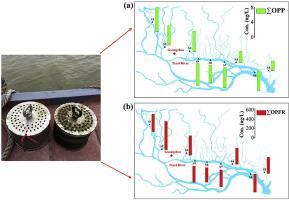Ecotoxicology and Environmental Safety ( IF 6.2 ) Pub Date : 2020-06-24 , DOI: 10.1016/j.ecoenv.2020.110891 Jingjing Xiong 1 , Huizhen Li 1 , Xue Ma 1 , Baoxiang Tan 1 , Jing You 1

|
Organophosphate ester contaminants, including organophosphate pesticides (OPPs) and organophosphate flame retardants (OPFRs) are ubiquitous in surface water and pose a significant risk to aquatic organisms, thus it is important to develop effective methods for long-term monitoring of these emerging compounds. Polar organic chemical integrative sampler (POCIS) has become a promising monitoring tool for waterborne contaminants, yet recent studies found that the commonly used polyethersulfone (PES) membrane strongly sorbed some moderately hydrophobic compounds, resulting in long lag-phase for chemical accumulation in POCIS. In the present study, 0.45-μm nylon membranes was selected as POCIS diffusion-limiting membrane to design a new POCIS-Nylon configuration for analyzing moderately hydrophobic OPPs and OPFRs in water. The POCIS-Nylon had negligible lag-phase due to low sorption of OPPs and OPFRs to nylon membrane. Meanwhile, linear accumulation time and sensitivity for target contaminants using POCIS-Nylon retained similar to the traditional POCIS. Water velocity and chemical concentration had little impact on sampling rate (Rs), validating that the POCIS-Nylon was suitable for various water conditions. Finally, the occurrence of OPPs and OPFRs in urban waterways of Guangzhou, China was evaluated using the POCIS-Nylon with Rs values that were calibrated in the laboratory. The average concentration of OPPs was 4.97 ± 1.35 ng/L (range: 2.64 ± 1.28–6.54 ± 0.18 ng/L) and the average concentration of OPFRs was 400 ± 88 ng/L (range: 316 ± 24–615 ± 36 ng/L) across nine sampling sites. The present study provides a way to resolve the inherent challenge of accumulating hydrophobic substances by POCIS.









































 京公网安备 11010802027423号
京公网安备 11010802027423号